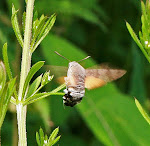The Large Heath (Coenonympha tullia) is a member of the family of ‘brown’ butterflies which includes the Meadow Brown and Small Heath. It is quite scarce in the UK where it is has a high priority conservation status. In the south of its range it is only found at a few localities in Wales and northern England but is more frequent in Scotland. In Europe it is designated as ‘vulnerable’ and is in decline in many countries.
.jpg)
[subsp. davus, the southern and most strongly marked form with many well-defined eye-spots]
The Large Heath has a specialised habitat requirement: lowland raised bogs, blanket bogs, or damp acidic moorland. Its main larval food-plant is Hare’s-foot Cottongrass (Eriophorum vaginatum). As well as flying in sunshine it can also do so in dull weather provided that it is warm. When feeding on its usual nectar source of heathers, epecially the Cross-leaved Heath (Erica tetralix), it invariably settles with it wings folded so making the upper-sides difficult to examine.
.jpg)
[Typical raised bog habitat of the Large Heath with the yellow Bog Asphodel in the right foreground]
Seen at an acidic bog in north Cumbria in the cool dull conditions pertaining on July 5th, only a few were flying in the more sheltered depressions in the bog but others were well concealed in the heather. The butterfly here is subspecies polydama, so defined by the strength of its wing markings being intermediate between those of the more southern UK localities (subsp. davus) and those of northern Scotland (subsp. scotica).
.jpg)
.jpg)
[subsp. polydama, the less clearly marked, intermediate form from north Cumbria (both above)]
Three days later on July 8th at its classic site at Meathop in south Cumbria, many subsp. davus were flying in breezy but much brighter conditions. This locality and the one seen in the north earlier appear very similar in habitat and vegetation. However, differences in the markings on the butterfly’s underwing are very apparent with those at Meathop showing much more well-defined spots (ocelli) whereas those at the other site (subsp. polydama) have paler wing undersides and fewer, less clearly defined spots. In the far north of Scotland, the underside spots are scarcely visible (subsp. scotica). How clear-cut these subspecies are in reality may be debatable since there seems to be a gradual transition from south to north.
.jpg)
.jpg)
[subsp. davus at Meathop (both above)]
When seen in flight at a distance, it might perhaps be confused with the Small Heath (Coenonympha pamphilus) since the differences in wing-span are relatively slight.
.jpg)
[Small Heath]
.jpg)






No comments:
Post a Comment